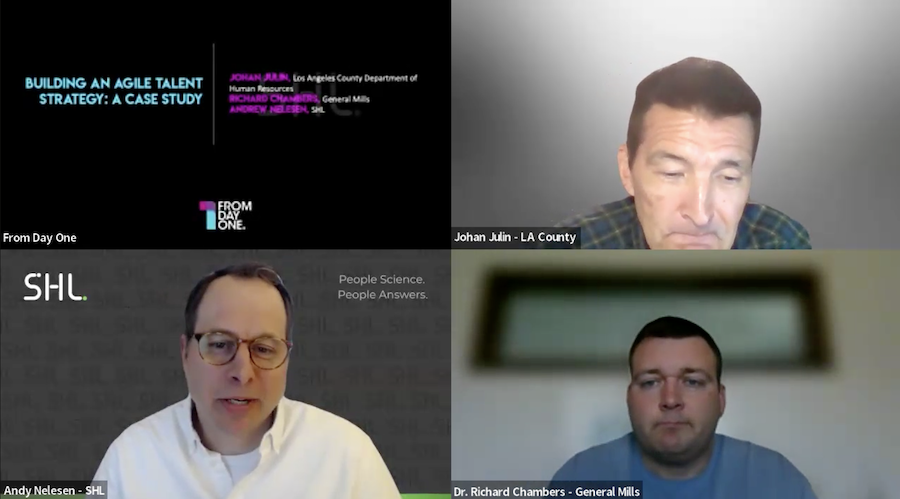Winning Strategies for Delivering an Inclusive Employee-Engagement Experience
The integration of new technology has transformed HR, enabling people leaders to shift their focus from traditional desk tasks to using this technology to build more inclusive and genuinely engaging workplaces.Sloan Kendall, head of global partnerships at Blink, and Caroline Mikhail, director of advisory services at LineZero, spoke in a thought leadership spotlight about winning strategies for delivering an inclusive employee-engagement experience at From Day One’s November virtual conference.The Five Engagement StrategiesThe first key strategy is leveraging technology to create an inclusive experience. Newer technology should meet employees where they are, provide easy authentication, and be highly personalized.For example, Blink helped a transportation company improve communication with their non-tech-oriented frontline workers using a mobile app with manager-led activation, says Mikhail. This successfully executed and personalized solution accommodated employees who have access to mobile phones instead of computers.Caroline Mikhail, director of advisory services at LineZero, spoke during the thought leadership spotlight (company photoThe second strategy is utilizing the strengths of a multigenerational workforce, as the social skills and technological knowledge of each generation differ from one another. Reverse mentorship programs facilitate younger generation employees sharing modern tech knowledge with older generation employees. Further, they learn valuable social skills from older employees.A workforce with diverse and inclusive skill sets enables leaders to use modern social tools, like short-form videos, to share information and provide feedback effectively. This approach ensures that socially and culturally relevant communication channels are accessible and beneficial for all employees.A third key strategy is to develop authentic connections in the workplace. When combined with technology, it cultivates more authentic employee engagement.Shadowing programs are ways for company executives and leaders to meet employees within different departments and learn about their daily responsibilities. Posting videos of the experience, featuring different employee experiences each time, encourages participation and enhances employees’ connection to one another.Other mentorship and development programs further facilitate direct communication between leaders and employees. Mikhail shared how an executive created a skill-sharing channel to recommend books and create discussion among employees. Such programs and initiatives, enhanced by new social mediums using technology, provide enriching and unique engagement where employees feel authentically seen, understood, and appreciated by their leaders and peers.The fourth strategy is to embrace champions as workplace ambassadors. Champions further help employees adapt to new technology and communication channels by answering questions and explaining the advantages to employees and the organization.The fifth key strategy is data-driven iteration. While traditional data remains essential for informed decision-making and improving financial outcomes, leveraging technology to filter and display diverse employee data on dashboards enables leaders to better strategize around engagement and development.They can obtain data on individual employees and teams and access summarized data revealing specific trends, helping people leaders create relevant solutions and development and mentorship opportunities. More inclusive datasets also inform leaders on the ways new tools are used so they can shift to more intuitive approaches that reap the most benefits.Inclusivity MattersInclusive solutions sustain hybrid workplaces. Frontline workers aren’t working at desks on computers and may not see their supervisors, managers, or people leaders on a day-to-day basis.Making technological innovation accessible to all employees drives better business outcomes by addressing the unique needs of both teams and individuals.Inclusive engagement fosters stronger peer connections through improved internal communication, boosts productivity by delivering role-specific solutions, and increases employee visibility through diverse social engagement channels.Kendall highlighted the partnership between Blink, a mobile-first employee experience and communication platform, and LineZero, a consultancy specializing in employee experience and change management. Together, they aim to help organizations strengthen connection, culture, and communication in the digital age.“Together we’re really setting up to deliver an experience that enables organizations to empower their employees to better communicate, to engage, and to access relevant systems and tools all in one centralized application,” said Kendall.Editor's note: From Day One thanks our partner, LineZero, for sponsoring this thought leadership spotlight. Stephanie Reed is a freelance news, marketing, and content writer. Much of her work features small business owners throughout diverse industries. She is passionate about promoting small, ethical, and eco-conscious businesses.





